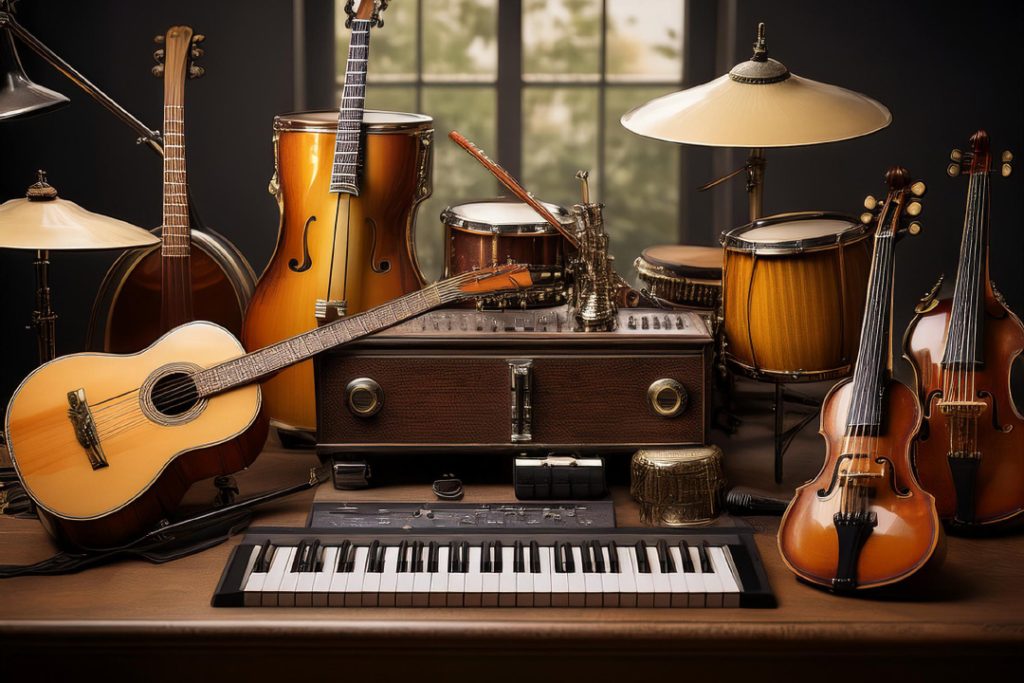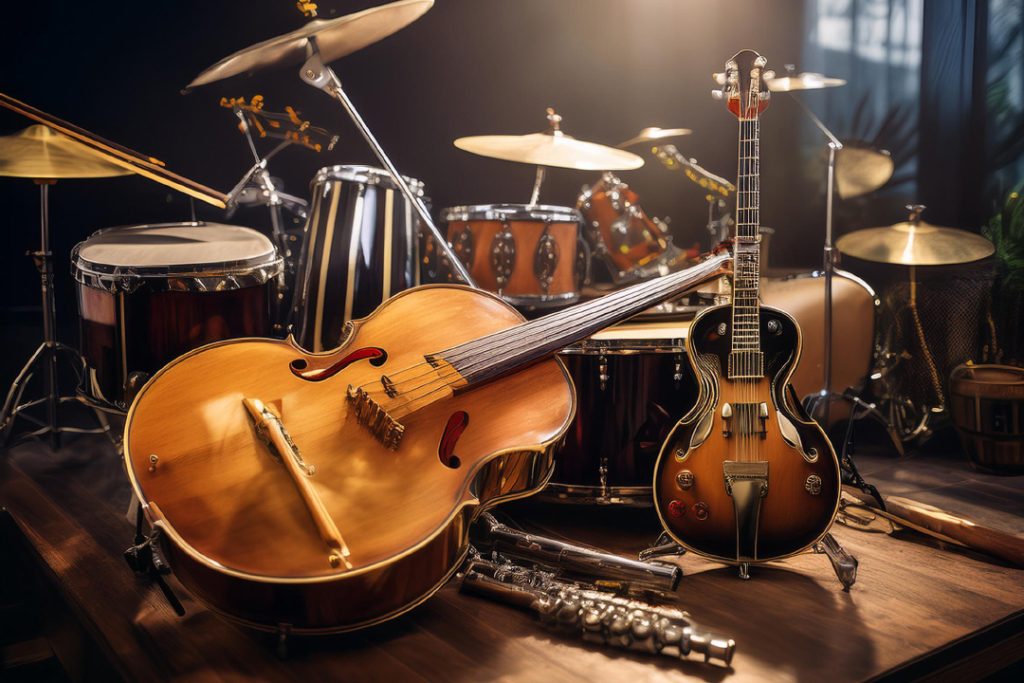Spark Your Creativity with Music Production
Discovering My Passion for Music Production
Let’s rewind to the moment I discovered music production. The thrill of crafting my own rhythms and melodies was something else. As a kid, I was always into music, playing different instruments, and singing in the choir. But it wasn’t until I got my hands on music production software that I truly felt the magic.
Picture this: me, huddled over my computer, playing around with different sounds, stacking tracks, and fine-tuning effects. It felt like creating a work of art, but instead of paints and brushes, I was using beats and tunes. Each new project was a hit of excitement, as fresh ways to express my musical ideas kept popping up.
Playing with Music Production Software
The coolest part of using music production software is the endless features it brings. From cool synth sounds to mixing effects, each tool is like finding a hidden gem. Diving into these tools is a wild ride of its own.
One feature I can’t get enough of is tweaking sounds on the fly. Want to add some echo to vocals? Done. How about cranking up the distortion on a guitar riff? Easy. Layering drum beats? No problem. Not only does this up my game, but it also gives my tracks a unique flavor that screams me.
| Tools | Features |
|---|---|
| Synthesizers | Craft and tweak electronic sounds |
| Samplers | Drop in pre-recorded sounds |
| Sequencers | Arrange and build your tracks |
| Effects | Play around with reverb, delay, distortion, and more |
But the fun doesn’t stop when the track’s done. Sharing my beats with friends and fellow musicians opens doors for feedback and teamwork. It’s a blast seeing others jam to or even remix my creations. If you’re curious about more ways to share your music, check out our guides on music streaming services and local music festivals.
Music production isn’t just about making songs; it’s about changing our relationship with music. Every click, every adjustment – the possibilities are as vast as your imagination. So, if you’re someone who loves to explore different music genres or simply enjoys a good creative challenge, music production could be your next big thing.
The Power of Music Production Software
What is Music Production Software?
I remember the first time I messed around with music production software, it flipped my world upside-down. This magical tool, known as a Digital Audio Workstation (DAW), is like having a full-fledged recording studio on your computer. It’s where all those musical seeds you plant can grow into full-blown tracks.
Music production software is your home base for recording audio, organizing your tracks, sprinkling in effects, and fine-tuning your masterpiece until it’s polished and shining. From a catchy chorus to an epic movie soundtrack, a DAW brings everything together in one place. The creative potential? Limitless and absolutely exhilarating.
| Feature | What It Does |
|---|---|
| Recording | Captures audio from instruments and vocals. |
| Arrangement | Lays out and sequences different parts. |
| Effects | Adds magic with reverb, delay, or distortion. |
| Mixing | Balances levels and panning of multiple tracks. |
| Mastering | Puts the finishing touches on your mix. |
Everything You Need to Unleash Your Creativity
When I first dove into a DAW, it felt like stepping into Willy Wonka’s music factory—endless possibilities and tools designed to get those creative juices flowing. These platforms are versatile enough to handle anything from groovy electronic beats to soulful ballads or heavy rock anthems.
Virtual Instruments: These are your digital versions of real instruments. Pianos, drums, and synthesizers are all at your fingertips, ready for you to experiment and create without needing a ton of physical gear.
Digital Effects: Think of these like special effects in movies. Whether you want to add a spooky echo or a lush reverb, the effects at your disposal can shape your sound and give it character.
Loop Libraries: For those starting out or in need of a quick spark, loop libraries offer pre-recorded samples. Just drag, drop, and you’re off to the races. It’s perfect for filling out your track or finding some inspiration when you’re stuck.
Automation: This is where the magic really happens. Automation lets you dynamically change volume, panning, effects, and more over time. It’s like having an invisible hand fine-tuning your mix to perfection.
| Tool | What It Does |
|---|---|
| Virtual Instruments | Emulates real instruments digitally. |
| Digital Effects | Alters sound with reverb, delay, etc. |
| Loop Libraries | Offers pre-recorded sound samples. |
| Automation | Automates changes in various parameters. |
Getting into music production software is like opening a treasure chest of musical goodies. There’s a learning curve (no doubt about it), but once you get the hang of it, the sky’s the limit. Whether you’re cooking up tracks for music festivals or aiming to get your beats on streaming services, the right software can make all the difference.
Do yourself a favor and dive into a DAW. Who knows? You might just create the next big hit.
Getting Started with Music Production Software
Jumping into music production is an adventure. The right software can turn your ideas into banging tracks. Let’s get you started.

Picking the Perfect Software
Choosing the right software is key. There are a few things to keep in mind:
- Skill Level: Newbie, sorta know your stuff, or total pro?
- Budget: How much moolah are you ready to throw down?
- Features: What bells and whistles do you need?
| Criteria | Beginner | Intermediate | Advanced |
|---|---|---|---|
| Skill Level | Basic features | More tools | Customization and advanced tools |
| Budget | Low | Some investment | Big spender |
| Features | Easy-to-use | More options | All the gadgets |
Need tips for different music styles? Check out our article on music genres.
Here’s a short list of some of the top music production software (DAWs) with descriptions and links to their official websites:
1. Ableton Live
- Description: A versatile DAW popular for live performances and studio production, known for its intuitive interface, powerful MIDI features, and unique session view for spontaneous creativity.
- Website: Ableton Live
2. FL Studio
- Description: Known for its user-friendly interface and strong loop-based music production workflow, FL Studio is favored by many electronic music producers and beatmakers.
- Website: FL Studio
3. Logic Pro (Mac only)
- Description: Apple’s professional DAW with a clean, intuitive design, offering extensive features for recording, editing, and mixing. It’s a go-to for many music producers on Mac.
- Website: Logic Pro
4. Pro Tools
- Description: Widely regarded as the industry standard for recording studios, Pro Tools excels in audio editing and mixing, making it ideal for professional producers and engineers.
- Website: Pro Tools
5. Cubase
- Description: A feature-rich DAW with robust MIDI and audio editing tools, Cubase is suitable for both beginners and professionals, especially for music composition and scoring.
- Website: Cubase
These DAWs offer a range of tools depending on the type of music production you’re interested in, from live performances to studio recording.
Installing and Setting Up
After picking your software, it’s time to install it. Here’s a basic how-to:
- Download: Head over to the software’s site and get the installer.
- Install: Follow the prompts to get it on your system.
- Activate: Punch in any activation codes you got.
- Setup: Tweak the audio preferences to match your gear (soundcard, speakers, etc.).
Here’s a quick setup guide:
| Step | Description |
|---|---|
| Download | Get the installer from the official website |
| Install | Run the installer and follow the instructions |
| Activate | Enter your license or activation key |
| Setup | Adjust settings to fit your audio interface |
Once installed, poke around the interface. Get to know the tools. This is where the magic starts. For more help, see our article on basic steps to produce your music.
Adding effects and plugins can really lift your sound, giving it that extra punch. Learn more in our guide on utilizing effects and plugins.
Remember, practice and experimenting are your best buddies. Soon, you’ll be pumping out tracks that scream “you.” For tips on getting your music out there, check out music streaming services and music festivals near me.
Making Your First Track: A Fun and Simple Guide
Starting on your first music track? Let’s make it a journey you’ll remember. Here’s a straightforward guide to help you get started.

Getting the Hang of the Interface
When I first opened my music production software, it looked like a spaceship’s control panel. But don’t worry—it gets easier. Let’s break it down.
- Track Area: Where you add and organize your audio bits and pieces.
- Toolbar: Your toolkit for slicing, dicing, and reshaping tracks.
- Mixer: Adjust your volumes, sprinkle in some effects, and decide where sounds come from.
- Plugin Area: Time to get creative with virtual instruments and effects.
Here’s a quick cheat sheet to the interface:
| Component | Description |
|---|---|
| Track Area | Arrange audio clips and tracks |
| Toolbar | Tools for editing |
| Mixer | Adjust volumes and effects |
| Plugin Area | Add instruments and effects |
Step-by-Step to Your Smash Hit
Putting together your first track is like building with Legos. Here’s your blueprint:
- Set Up a Project: Start by creating a new project. Decide on the tempo and key for your track.
- Add Tracks: Throw in different tracks for drums, bass, melody, and more. Each gets its lane.
- Record or Import Audio: Either play your heart out live or import some pre-recorded jams.
- Arrange Clips: Drag and drop your audio clips into the track area. Build sections like verse, chorus, and bridge.
- Edit and Trim: Use the toolbar to snip, cut, and polish your clips.
- Add Effects: Head to the mixer and plugin area to splash some reverb, delay, and other cool effects.
- Mix and Adjust Levels: Balance those volumes so everything gels together perfectly.
- Export the Track: When happy with your creation, export it as an mp3, wav, or whatever format you fancy.
Want to know more about spicing up your tracks? Check out my guide to adding effects and plugins.
Making music is like magic. Once you get the hang of the basics, the sky’s the limit. Ready to share your masterpiece? Read up on music streaming services to get it out there.
Make Your Music Pop
Playing around with music production software? That’s where the fun begins! After you lay down your first track, it’s time to make it pop and catch everyone’s ear. Let’s talk about boosting your sound with effects, plugins, and the nitty-gritty of mixing and mastering.
Spicing It Up with Effects and Plugins
Think of effects and plugins like the secret sauce in your grandma’s recipe—they add that extra zing. These tools can completely revamp your tracks, making them stand out in the best possible way.
Go-To Effects and What They Do:
- Reverb: Creates space, like an echo in a hall
- Delay: Adds repeats, making sounds bounce around
- Chorus: Makes a single sound feel like an ensemble
- EQ (Equalizer): Balances different sound frequencies
| Effect | What It Does | Examples |
|---|---|---|
| Reverb | Adds depth and space | Room, Hall |
| Delay | Echoes and repeats | Slapback, Ping Pong |
| Chorus | Thickens sounds | Vocal doubling |
| EQ | Balances frequencies | Boost bass, Cut treble |
Mess around with these effects to find your groove. Each one comes with sliders and knobs that you can fiddle with to get just the right vibe. Curious about how different music styles use these effects? Look it up and get inspired.
Mixing and Mastering: The Final Polish
Mixing and mastering turn your raw tracks into polished gems. Here’s the lowdown on how to nail each process:
Mixing
Mixing is all about blending the individual parts of your track into a harmonious whole. You tweak volumes, pan sounds left or right, and fine-tune with EQ and compression.
Mixing Steps:
- Volume Levels: Get each track to the right loudness.
- Panning: Move tracks across the stereo field for space.
- EQ Adjustments: Balance frequencies so they don’t clash.
- Compression: Keep volume levels steady.
| Step | What’s Involved | Why It Matters |
|---|---|---|
| Volume Levels | Volume tweaking | Clarity |
| Panning | Stereo positioning | Depth |
| EQ Adjustments | Frequency tweaks | Clean sound |
| Compression | Control dynamics | Consistent levels |
Mastering
Mastering is like giving your track a final coat of gloss. It fine-tunes the mix for different listening setups and formats. The aim? Make everything sound fantastic, no matter where it’s played.
Mastering Steps:
- Final EQ Tweaks: Shape the overall sound.
- Compression and Limiting: Keep loudness in check.
- Stereo Enhancing: Broaden the stereo image for richness.
- Prep for Distribution: Get ready for digital, vinyl, and more.
For those who live and breathe sound, trying out different effects and mixing styles can take your tracks to another level. Keep learning and tweaking until you nail your signature sound. Once you’re ready, sharing on music streaming sites is a great next step.
So, dive in and let your creativity run wild with mixing, mastering, and cool effects. With the right tools, your music will not just be heard—it will be felt.
Elevate Your Music Game
Jumping into music production has been a wild ride. With the right music production software, each tune I create becomes a journey to new sonic heights.
Play Around with Different Tunes
One of the coolest parts about using music software is the freedom to mess around with different styles and sounds. Whether I’m vibing with hip-hop, jamming to electronic beats, immersing in classical harmonies, or rocking out, there’s always something new to try. Mixing it up like this helps me find my groove and expand my musical palette.
Here’s a peek at some of the genres I like to toy with:
| Genre | Key Ingredients |
|---|---|
| Hip-Hop | Beats, Drum Machines, Samples |
| Electronic | Synthesizers, Loops, Effects |
| Classical | Orchestral Instruments, Strings, Piano |
| Rock | Guitars, Drums, Bass, Vocals |
Curious about diving into different genres? Check out our all-out guide to music genres.
Show Your Tunes to the World
Making music is awesome, but sharing it is where the magic happens. Thanks to the digital age, sharing my tracks has never been easier. Music streaming platforms and social media are gold mines for getting my music out there.
Here’s my go-to plan for sharing my beats:
- Upload tracks to a streaming platform.
- Blast links on social media.
- Drop tracks in online music groups and forums.
- Hit up local music festivals with live performances.
Doing all this helps me reach more folks and get feedback from other music lovers. The comments, shares, and likes push me to keep creating and trying new things.
For those who dig fun facts and want to keep listeners engaged, our collection of music trivia questions is a perfect way to add some spice to your musical adventures.
As I keep trying new styles and sharing my work, my creativity peaks and my skills get sharper. The potential with music production software is massive, and this journey has just started!
Here some recommended links selected for you: The Best Books of the Month, Todays best Deals at Amazon, Best Sellers in Cell Phones & Accessories and last but not least the easy and great way to send a gift for the holidays: Amazon.com eGift Card (Instant Email or Text Delivery).




